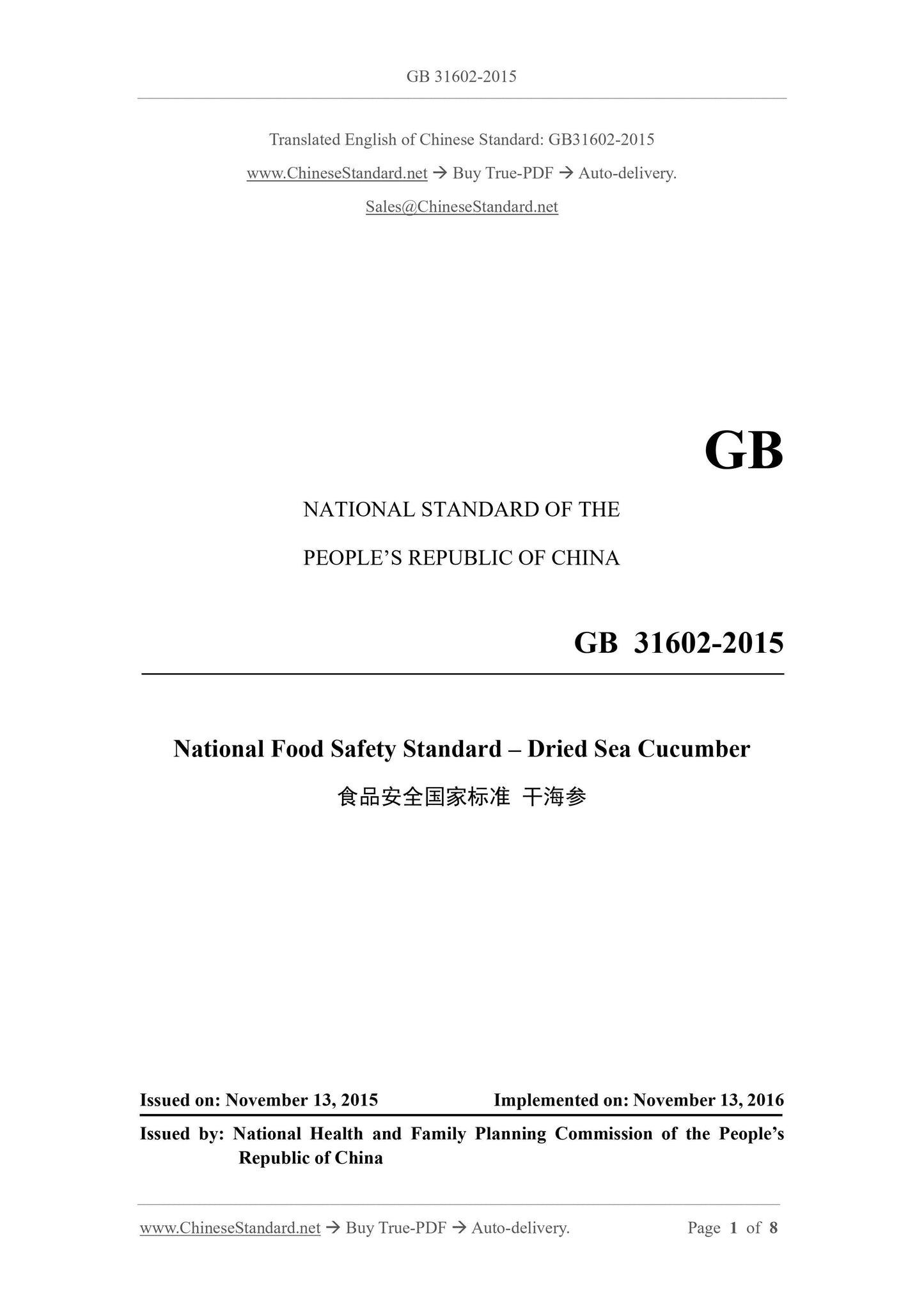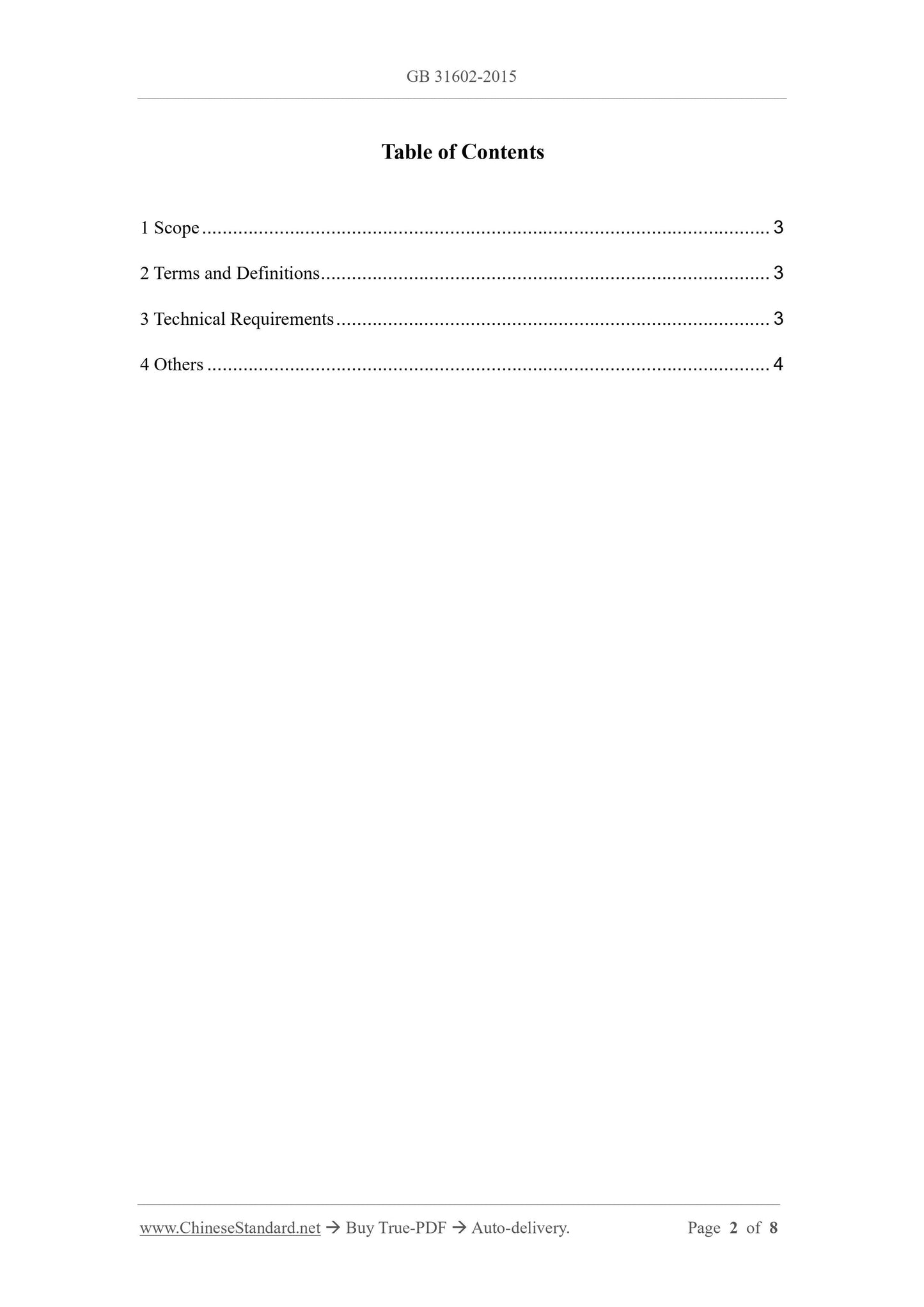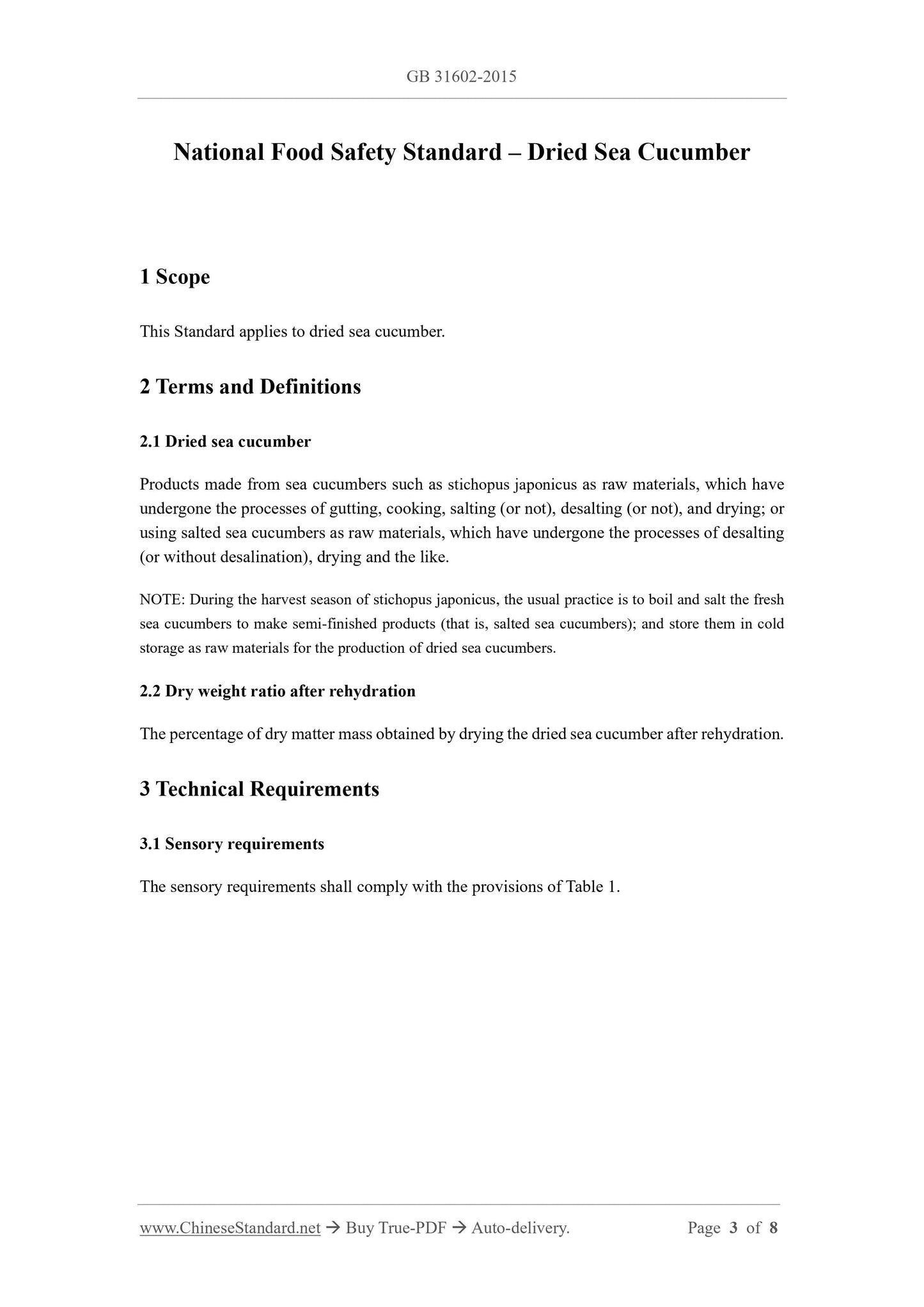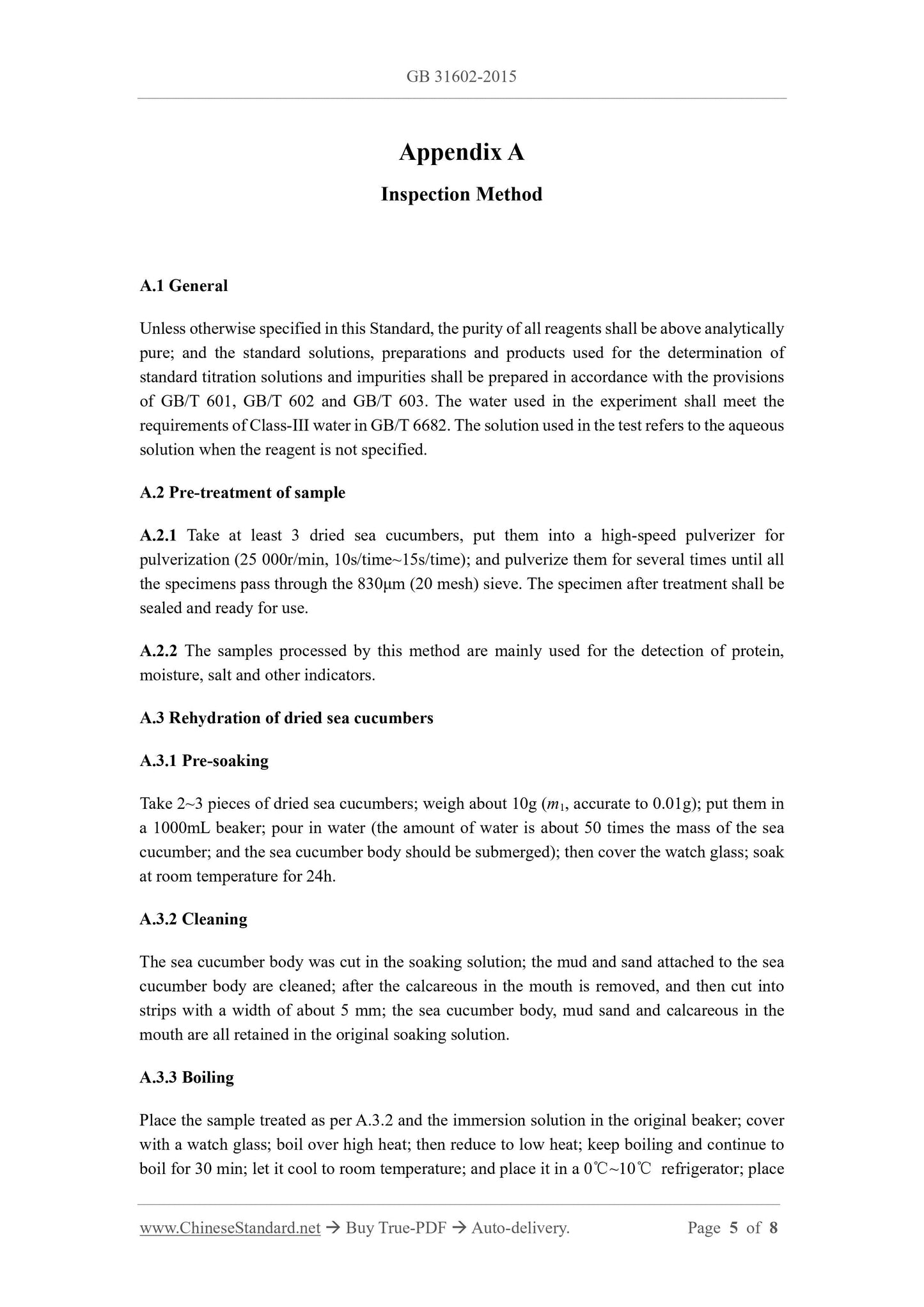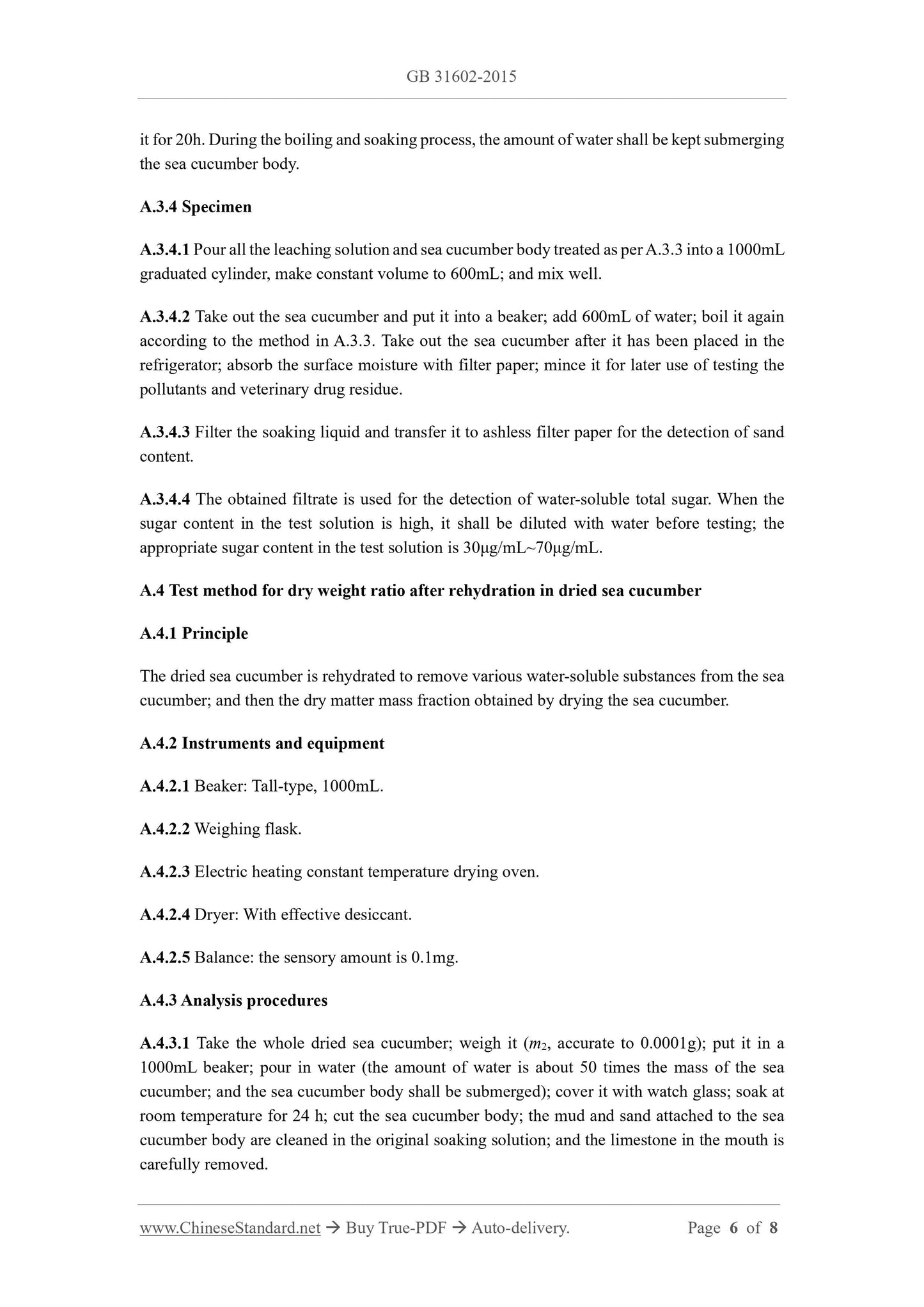1
/
of
5
www.ChineseStandard.us -- Field Test Asia Pte. Ltd.
GB 31602-2015 English PDF
GB 31602-2015 English PDF
Regular price
$125.00
Regular price
Sale price
$125.00
Unit price
/
per
Shipping calculated at checkout.
Couldn't load pickup availability
GB 31602-2015: National food safety standard -- Dried sea cucumber
Delivery: 9 seconds. Download (& Email) true-PDF + Invoice.
Get Quotation: Click GB 31602-2015 (Self-service in 1-minute)
Historical versions (Master-website): GB 31602-2015
Preview True-PDF (Reload/Scroll-down if blank)
GB 31602-2015
NATIONAL STANDARD OF THE
PEOPLE’S REPUBLIC OF CHINA
National Food Safety Standard – Dried Sea Cucumber
ISSUED ON. NOVEMBER 13, 2015
IMPLEMENTED ON. NOVEMBER 13, 2016
Issued by. National Health and Family Planning Commission of the People’s
Republic of China
Table of Contents
1 Scope... 3
2 Terms and Definitions... 3
3 Technical Requirements... 3
4 Others... 4
National Food Safety Standard – Dried Sea Cucumber
1 Scope
This Standard applies to dried sea cucumber.
2 Terms and Definitions
2.1 Dried sea cucumber
Products made from sea cucumbers such as stichopus japonicus as raw materials, which have
undergone the processes of gutting, cooking, salting (or not), desalting (or not), and drying; or
using salted sea cucumbers as raw materials, which have undergone the processes of desalting
(or without desalination), drying and the like.
NOTE. During the harvest season of stichopus japonicus, the usual practice is to boil and salt the fresh
sea cucumbers to make semi-finished products (that is, salted sea cucumbers); and store them in cold
storage as raw materials for the production of dried sea cucumbers.
2.2 Dry weight ratio after rehydration
The percentage of dry matter mass obtained by drying the dried sea cucumber after rehydration.
3 Technical Requirements
3.1 Sensory requirements
The sensory requirements shall comply with the provisions of Table 1.
Appendix A
Inspection Method
A.1 General
Unless otherwise specified in this Standard, the purity of all reagents shall be above analytically
pure; and the standard solutions, preparations and products used for the determination of
standard titration solutions and impurities shall be prepared in accordance with the provisions
of GB/T 601, GB/T 602 and GB/T 603.The water used in the experiment shall meet the
requirements of Class-III water in GB/T 6682.The solution used in the test refers to the aqueous
solution when the reagent is not specified.
A.2 Pre-treatment of sample
A.2.1 Take at least 3 dried sea cucumbers, put them into a high-speed pulverizer for
pulverization (25 000r/min, 10s/time~15s/time); and pulverize them for several times until all
the specimens pass through the 830μm (20 mesh) sieve. The specimen after treatment shall be
sealed and ready for use.
A.2.2 The samples processed by this method are mainly used for the detection of protein,
moisture, salt and other indicators.
A.3 Rehydration of dried sea cucumbers
A.3.1 Pre-soaking
Take 2~3 pieces of dried sea cucumbers; weigh about 10g (m1, accurate to 0.01g); put them in
a 1000mL beaker; pour in water (the amount of water is about 50 times the mass of the sea
cucumber; and the sea cucumber body should be submerged); then cover the watch glass; soak
at room temperature for 24h.
A.3.2 Cleaning
The sea cucumber body was cut in the soaking solution; the mud and sand attached to the sea
cucumber body are cleaned; after the calcareous in the mouth is removed, and then cut into
strips with a width of about 5 mm; the sea cucumber body, mud sand and calcareous in the
mouth are all retained in the original soaking solution.
A.3.3 Boiling
Place the sample treated as per A.3.2 and the immersion solution in the original beaker; cover
with a watch glass; boil over high heat; then reduce to low heat; keep boiling and continue to
boil for 30 min; let it cool to room temperature; and place it in a 0℃~10℃ refrigerator; place
it for 20h. During the boiling and soaking process, the amount of water shall be kept submerging
the sea cucumber body.
A.3.4 Specimen
A.3.4.1 Pour all the leaching solution and sea cucumber body treated as per A.3.3 into a 1000mL
graduated cylinder, make constant volume to 600mL; and mix well.
A.3.4.2 Take out the sea cucumber and put it into a beaker; add 600mL of water; boil it again
according to the method in A.3.3.Take out the sea cucumber after it has been placed in the
refrigerator; absorb the surface moisture with filter paper; mince it for later use of testing the
pollutants and veterinary drug residue.
A.3.4.3 Filter the soaking liquid and transfer it to ashless filter paper for the detection of sand
content.
A.3.4.4 The obtained filtrate is used for the detection of water-soluble total sugar. When the
sugar content in the test solution is high, it shall be diluted with water before testing; the
appropriate sugar content in the test solution is 30μg/mL~70μg/mL.
A.4 Test method for dry weight ratio after rehydration in dried sea cucumber
A.4.1 Principle
The dried sea cucumber is rehydrated to remove various water-soluble substances from the sea
cucumber; and then the dry matter mass fraction obtained by drying the sea cucumber.
A.4.2 Instruments and equipment
A.4.2.1 Beaker. Tall-type, 1000mL.
A.4.2.2 Weighing flask.
A.4.2.3 Electric heating constant temperature drying oven.
A.4.2.4 Dryer. With effective desiccant.
A.4.2.5 Balance. the sensory amount is 0.1mg.
A.4.3 Analysis procedures
A.4.3.1 Take the whole dried sea cucumber; weigh it (m2, accurate to 0.0001g); put it in a
1000mL beaker; pour in water (the amount of water is about 50 times the mass of the sea
cucumber; and the sea cucumber body shall be submerged); cover it with watch glass; soak at
room temperature for 24 h; cut the sea cucumber body; the mud and sand attached to the sea
cucumber body are cleaned in the original soaking solution; and the limestone in the mouth is
carefully removed.
GB 31602-2015
NATIONAL STANDARD OF THE
PEOPLE’S REPUBLIC OF CHINA
National Food Safety Standard – Dried Sea Cucumber
ISSUED ON. NOVEMBER 13, 2015
IMPLEMENTED ON. NOVEMBER 13, 2016
Issued by. National Health and Family Planning Commission of the People’s
Republic of China
Table of Contents
1 Scope... 3
2 Terms and Definitions... 3
3 Technical Requirements... 3
4 Others... 4
National Food Safety Standard – Dried Sea Cucumber
1 Scope
This Standard applies to dried sea cucumber.
2 Terms and Definitions
2.1 Dried sea cucumber
Products made from sea cucumbers such as stichopus japonicus as raw materials, which have
undergone the processes of gutting, cooking, salting (or not), desalting (or not), and drying; or
using salted sea cucumbers as raw materials, which have undergone the processes of desalting
(or without desalination), drying and the like.
NOTE. During the harvest season of stichopus japonicus, the usual practice is to boil and salt the fresh
sea cucumbers to make semi-finished products (that is, salted sea cucumbers); and store them in cold
storage as raw materials for the production of dried sea cucumbers.
2.2 Dry weight ratio after rehydration
The percentage of dry matter mass obtained by drying the dried sea cucumber after rehydration.
3 Technical Requirements
3.1 Sensory requirements
The sensory requirements shall comply with the provisions of Table 1.
Appendix A
Inspection Method
A.1 General
Unless otherwise specified in this Standard, the purity of all reagents shall be above analytically
pure; and the standard solutions, preparations and products used for the determination of
standard titration solutions and impurities shall be prepared in accordance with the provisions
of GB/T 601, GB/T 602 and GB/T 603.The water used in the experiment shall meet the
requirements of Class-III water in GB/T 6682.The solution used in the test refers to the aqueous
solution when the reagent is not specified.
A.2 Pre-treatment of sample
A.2.1 Take at least 3 dried sea cucumbers, put them into a high-speed pulverizer for
pulverization (25 000r/min, 10s/time~15s/time); and pulverize them for several times until all
the specimens pass through the 830μm (20 mesh) sieve. The specimen after treatment shall be
sealed and ready for use.
A.2.2 The samples processed by this method are mainly used for the detection of protein,
moisture, salt and other indicators.
A.3 Rehydration of dried sea cucumbers
A.3.1 Pre-soaking
Take 2~3 pieces of dried sea cucumbers; weigh about 10g (m1, accurate to 0.01g); put them in
a 1000mL beaker; pour in water (the amount of water is about 50 times the mass of the sea
cucumber; and the sea cucumber body should be submerged); then cover the watch glass; soak
at room temperature for 24h.
A.3.2 Cleaning
The sea cucumber body was cut in the soaking solution; the mud and sand attached to the sea
cucumber body are cleaned; after the calcareous in the mouth is removed, and then cut into
strips with a width of about 5 mm; the sea cucumber body, mud sand and calcareous in the
mouth are all retained in the original soaking solution.
A.3.3 Boiling
Place the sample treated as per A.3.2 and the immersion solution in the original beaker; cover
with a watch glass; boil over high heat; then reduce to low heat; keep boiling and continue to
boil for 30 min; let it cool to room temperature; and place it in a 0℃~10℃ refrigerator; place
it for 20h. During the boiling and soaking process, the amount of water shall be kept submerging
the sea cucumber body.
A.3.4 Specimen
A.3.4.1 Pour all the leaching solution and sea cucumber body treated as per A.3.3 into a 1000mL
graduated cylinder, make constant volume to 600mL; and mix well.
A.3.4.2 Take out the sea cucumber and put it into a beaker; add 600mL of water; boil it again
according to the method in A.3.3.Take out the sea cucumber after it has been placed in the
refrigerator; absorb the surface moisture with filter paper; mince it for later use of testing the
pollutants and veterinary drug residue.
A.3.4.3 Filter the soaking liquid and transfer it to ashless filter paper for the detection of sand
content.
A.3.4.4 The obtained filtrate is used for the detection of water-soluble total sugar. When the
sugar content in the test solution is high, it shall be diluted with water before testing; the
appropriate sugar content in the test solution is 30μg/mL~70μg/mL.
A.4 Test method for dry weight ratio after rehydration in dried sea cucumber
A.4.1 Principle
The dried sea cucumber is rehydrated to remove various water-soluble substances from the sea
cucumber; and then the dry matter mass fraction obtained by drying the sea cucumber.
A.4.2 Instruments and equipment
A.4.2.1 Beaker. Tall-type, 1000mL.
A.4.2.2 Weighing flask.
A.4.2.3 Electric heating constant temperature drying oven.
A.4.2.4 Dryer. With effective desiccant.
A.4.2.5 Balance. the sensory amount is 0.1mg.
A.4.3 Analysis procedures
A.4.3.1 Take the whole dried sea cucumber; weigh it (m2, accurate to 0.0001g); put it in a
1000mL beaker; pour in water (the amount of water is about 50 times the mass of the sea
cucumber; and the sea cucumber body shall be submerged); cover it with watch glass; soak at
room temperature for 24 h; cut the sea cucumber body; the mud and sand attached to the sea
cucumber body are cleaned in the original soaking solution; and the limestone in the mouth is
carefully removed.
Delivery: 9 seconds. Download (& Email) true-PDF + Invoice.
Get Quotation: Click GB 31602-2015 (Self-service in 1-minute)
Historical versions (Master-website): GB 31602-2015
Preview True-PDF (Reload/Scroll-down if blank)
GB 31602-2015
NATIONAL STANDARD OF THE
PEOPLE’S REPUBLIC OF CHINA
National Food Safety Standard – Dried Sea Cucumber
ISSUED ON. NOVEMBER 13, 2015
IMPLEMENTED ON. NOVEMBER 13, 2016
Issued by. National Health and Family Planning Commission of the People’s
Republic of China
Table of Contents
1 Scope... 3
2 Terms and Definitions... 3
3 Technical Requirements... 3
4 Others... 4
National Food Safety Standard – Dried Sea Cucumber
1 Scope
This Standard applies to dried sea cucumber.
2 Terms and Definitions
2.1 Dried sea cucumber
Products made from sea cucumbers such as stichopus japonicus as raw materials, which have
undergone the processes of gutting, cooking, salting (or not), desalting (or not), and drying; or
using salted sea cucumbers as raw materials, which have undergone the processes of desalting
(or without desalination), drying and the like.
NOTE. During the harvest season of stichopus japonicus, the usual practice is to boil and salt the fresh
sea cucumbers to make semi-finished products (that is, salted sea cucumbers); and store them in cold
storage as raw materials for the production of dried sea cucumbers.
2.2 Dry weight ratio after rehydration
The percentage of dry matter mass obtained by drying the dried sea cucumber after rehydration.
3 Technical Requirements
3.1 Sensory requirements
The sensory requirements shall comply with the provisions of Table 1.
Appendix A
Inspection Method
A.1 General
Unless otherwise specified in this Standard, the purity of all reagents shall be above analytically
pure; and the standard solutions, preparations and products used for the determination of
standard titration solutions and impurities shall be prepared in accordance with the provisions
of GB/T 601, GB/T 602 and GB/T 603.The water used in the experiment shall meet the
requirements of Class-III water in GB/T 6682.The solution used in the test refers to the aqueous
solution when the reagent is not specified.
A.2 Pre-treatment of sample
A.2.1 Take at least 3 dried sea cucumbers, put them into a high-speed pulverizer for
pulverization (25 000r/min, 10s/time~15s/time); and pulverize them for several times until all
the specimens pass through the 830μm (20 mesh) sieve. The specimen after treatment shall be
sealed and ready for use.
A.2.2 The samples processed by this method are mainly used for the detection of protein,
moisture, salt and other indicators.
A.3 Rehydration of dried sea cucumbers
A.3.1 Pre-soaking
Take 2~3 pieces of dried sea cucumbers; weigh about 10g (m1, accurate to 0.01g); put them in
a 1000mL beaker; pour in water (the amount of water is about 50 times the mass of the sea
cucumber; and the sea cucumber body should be submerged); then cover the watch glass; soak
at room temperature for 24h.
A.3.2 Cleaning
The sea cucumber body was cut in the soaking solution; the mud and sand attached to the sea
cucumber body are cleaned; after the calcareous in the mouth is removed, and then cut into
strips with a width of about 5 mm; the sea cucumber body, mud sand and calcareous in the
mouth are all retained in the original soaking solution.
A.3.3 Boiling
Place the sample treated as per A.3.2 and the immersion solution in the original beaker; cover
with a watch glass; boil over high heat; then reduce to low heat; keep boiling and continue to
boil for 30 min; let it cool to room temperature; and place it in a 0℃~10℃ refrigerator; place
it for 20h. During the boiling and soaking process, the amount of water shall be kept submerging
the sea cucumber body.
A.3.4 Specimen
A.3.4.1 Pour all the leaching solution and sea cucumber body treated as per A.3.3 into a 1000mL
graduated cylinder, make constant volume to 600mL; and mix well.
A.3.4.2 Take out the sea cucumber and put it into a beaker; add 600mL of water; boil it again
according to the method in A.3.3.Take out the sea cucumber after it has been placed in the
refrigerator; absorb the surface moisture with filter paper; mince it for later use of testing the
pollutants and veterinary drug residue.
A.3.4.3 Filter the soaking liquid and transfer it to ashless filter paper for the detection of sand
content.
A.3.4.4 The obtained filtrate is used for the detection of water-soluble total sugar. When the
sugar content in the test solution is high, it shall be diluted with water before testing; the
appropriate sugar content in the test solution is 30μg/mL~70μg/mL.
A.4 Test method for dry weight ratio after rehydration in dried sea cucumber
A.4.1 Principle
The dried sea cucumber is rehydrated to remove various water-soluble substances from the sea
cucumber; and then the dry matter mass fraction obtained by drying the sea cucumber.
A.4.2 Instruments and equipment
A.4.2.1 Beaker. Tall-type, 1000mL.
A.4.2.2 Weighing flask.
A.4.2.3 Electric heating constant temperature drying oven.
A.4.2.4 Dryer. With effective desiccant.
A.4.2.5 Balance. the sensory amount is 0.1mg.
A.4.3 Analysis procedures
A.4.3.1 Take the whole dried sea cucumber; weigh it (m2, accurate to 0.0001g); put it in a
1000mL beaker; pour in water (the amount of water is about 50 times the mass of the sea
cucumber; and the sea cucumber body shall be submerged); cover it with watch glass; soak at
room temperature for 24 h; cut the sea cucumber body; the mud and sand attached to the sea
cucumber body are cleaned in the original soaking solution; and the limestone in the mouth is
carefully removed.
GB 31602-2015
NATIONAL STANDARD OF THE
PEOPLE’S REPUBLIC OF CHINA
National Food Safety Standard – Dried Sea Cucumber
ISSUED ON. NOVEMBER 13, 2015
IMPLEMENTED ON. NOVEMBER 13, 2016
Issued by. National Health and Family Planning Commission of the People’s
Republic of China
Table of Contents
1 Scope... 3
2 Terms and Definitions... 3
3 Technical Requirements... 3
4 Others... 4
National Food Safety Standard – Dried Sea Cucumber
1 Scope
This Standard applies to dried sea cucumber.
2 Terms and Definitions
2.1 Dried sea cucumber
Products made from sea cucumbers such as stichopus japonicus as raw materials, which have
undergone the processes of gutting, cooking, salting (or not), desalting (or not), and drying; or
using salted sea cucumbers as raw materials, which have undergone the processes of desalting
(or without desalination), drying and the like.
NOTE. During the harvest season of stichopus japonicus, the usual practice is to boil and salt the fresh
sea cucumbers to make semi-finished products (that is, salted sea cucumbers); and store them in cold
storage as raw materials for the production of dried sea cucumbers.
2.2 Dry weight ratio after rehydration
The percentage of dry matter mass obtained by drying the dried sea cucumber after rehydration.
3 Technical Requirements
3.1 Sensory requirements
The sensory requirements shall comply with the provisions of Table 1.
Appendix A
Inspection Method
A.1 General
Unless otherwise specified in this Standard, the purity of all reagents shall be above analytically
pure; and the standard solutions, preparations and products used for the determination of
standard titration solutions and impurities shall be prepared in accordance with the provisions
of GB/T 601, GB/T 602 and GB/T 603.The water used in the experiment shall meet the
requirements of Class-III water in GB/T 6682.The solution used in the test refers to the aqueous
solution when the reagent is not specified.
A.2 Pre-treatment of sample
A.2.1 Take at least 3 dried sea cucumbers, put them into a high-speed pulverizer for
pulverization (25 000r/min, 10s/time~15s/time); and pulverize them for several times until all
the specimens pass through the 830μm (20 mesh) sieve. The specimen after treatment shall be
sealed and ready for use.
A.2.2 The samples processed by this method are mainly used for the detection of protein,
moisture, salt and other indicators.
A.3 Rehydration of dried sea cucumbers
A.3.1 Pre-soaking
Take 2~3 pieces of dried sea cucumbers; weigh about 10g (m1, accurate to 0.01g); put them in
a 1000mL beaker; pour in water (the amount of water is about 50 times the mass of the sea
cucumber; and the sea cucumber body should be submerged); then cover the watch glass; soak
at room temperature for 24h.
A.3.2 Cleaning
The sea cucumber body was cut in the soaking solution; the mud and sand attached to the sea
cucumber body are cleaned; after the calcareous in the mouth is removed, and then cut into
strips with a width of about 5 mm; the sea cucumber body, mud sand and calcareous in the
mouth are all retained in the original soaking solution.
A.3.3 Boiling
Place the sample treated as per A.3.2 and the immersion solution in the original beaker; cover
with a watch glass; boil over high heat; then reduce to low heat; keep boiling and continue to
boil for 30 min; let it cool to room temperature; and place it in a 0℃~10℃ refrigerator; place
it for 20h. During the boiling and soaking process, the amount of water shall be kept submerging
the sea cucumber body.
A.3.4 Specimen
A.3.4.1 Pour all the leaching solution and sea cucumber body treated as per A.3.3 into a 1000mL
graduated cylinder, make constant volume to 600mL; and mix well.
A.3.4.2 Take out the sea cucumber and put it into a beaker; add 600mL of water; boil it again
according to the method in A.3.3.Take out the sea cucumber after it has been placed in the
refrigerator; absorb the surface moisture with filter paper; mince it for later use of testing the
pollutants and veterinary drug residue.
A.3.4.3 Filter the soaking liquid and transfer it to ashless filter paper for the detection of sand
content.
A.3.4.4 The obtained filtrate is used for the detection of water-soluble total sugar. When the
sugar content in the test solution is high, it shall be diluted with water before testing; the
appropriate sugar content in the test solution is 30μg/mL~70μg/mL.
A.4 Test method for dry weight ratio after rehydration in dried sea cucumber
A.4.1 Principle
The dried sea cucumber is rehydrated to remove various water-soluble substances from the sea
cucumber; and then the dry matter mass fraction obtained by drying the sea cucumber.
A.4.2 Instruments and equipment
A.4.2.1 Beaker. Tall-type, 1000mL.
A.4.2.2 Weighing flask.
A.4.2.3 Electric heating constant temperature drying oven.
A.4.2.4 Dryer. With effective desiccant.
A.4.2.5 Balance. the sensory amount is 0.1mg.
A.4.3 Analysis procedures
A.4.3.1 Take the whole dried sea cucumber; weigh it (m2, accurate to 0.0001g); put it in a
1000mL beaker; pour in water (the amount of water is about 50 times the mass of the sea
cucumber; and the sea cucumber body shall be submerged); cover it with watch glass; soak at
room temperature for 24 h; cut the sea cucumber body; the mud and sand attached to the sea
cucumber body are cleaned in the original soaking solution; and the limestone in the mouth is
carefully removed.
Share
